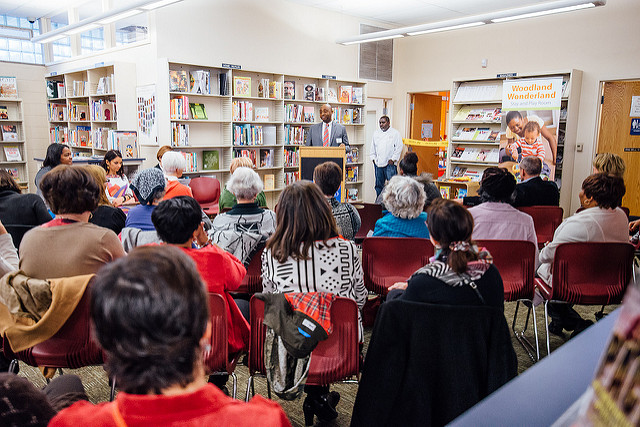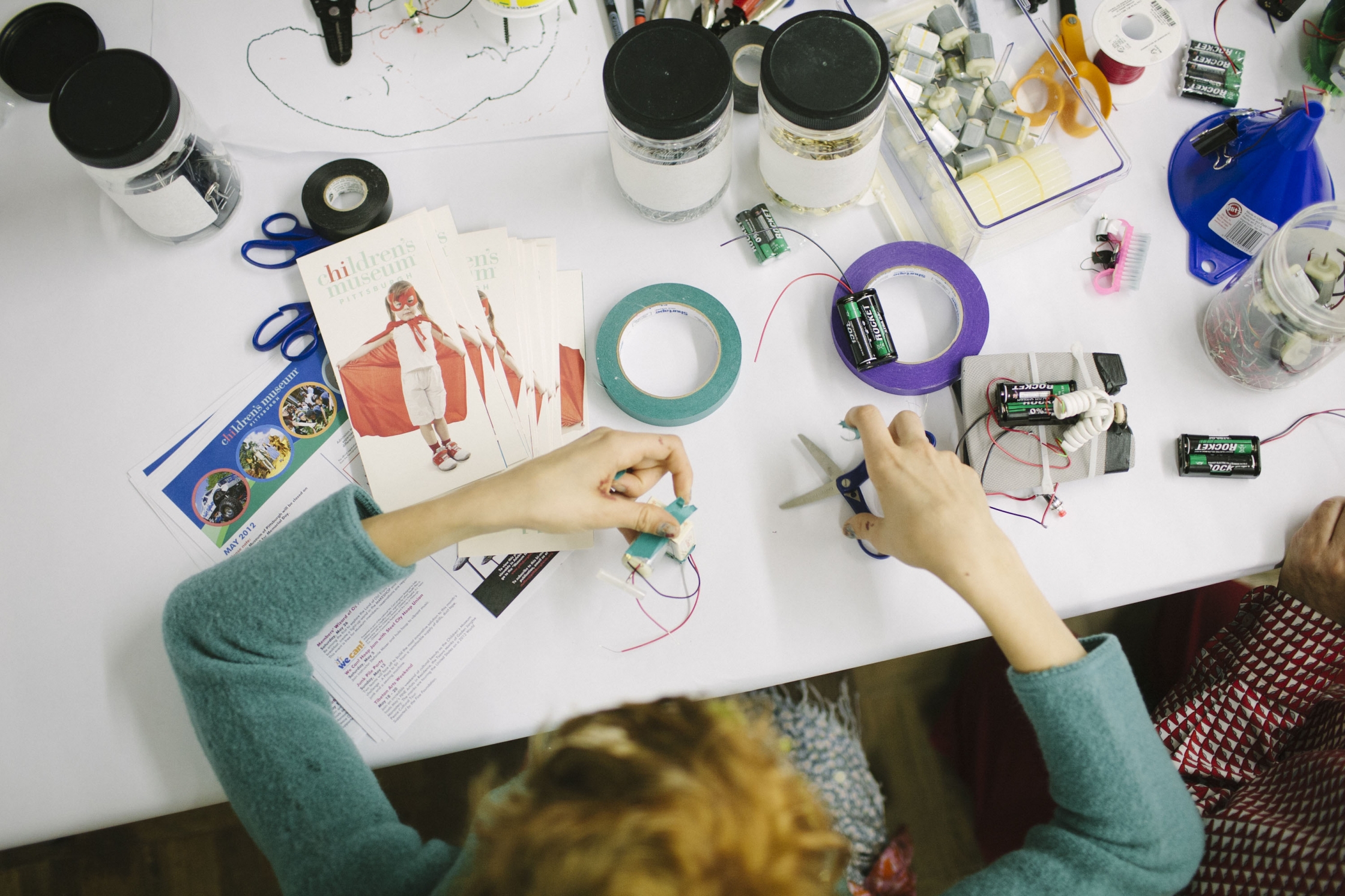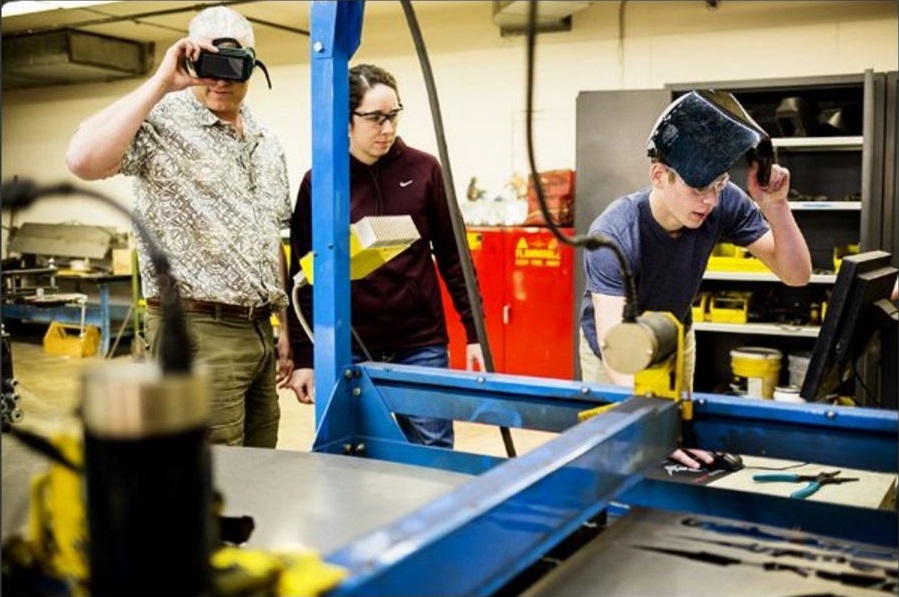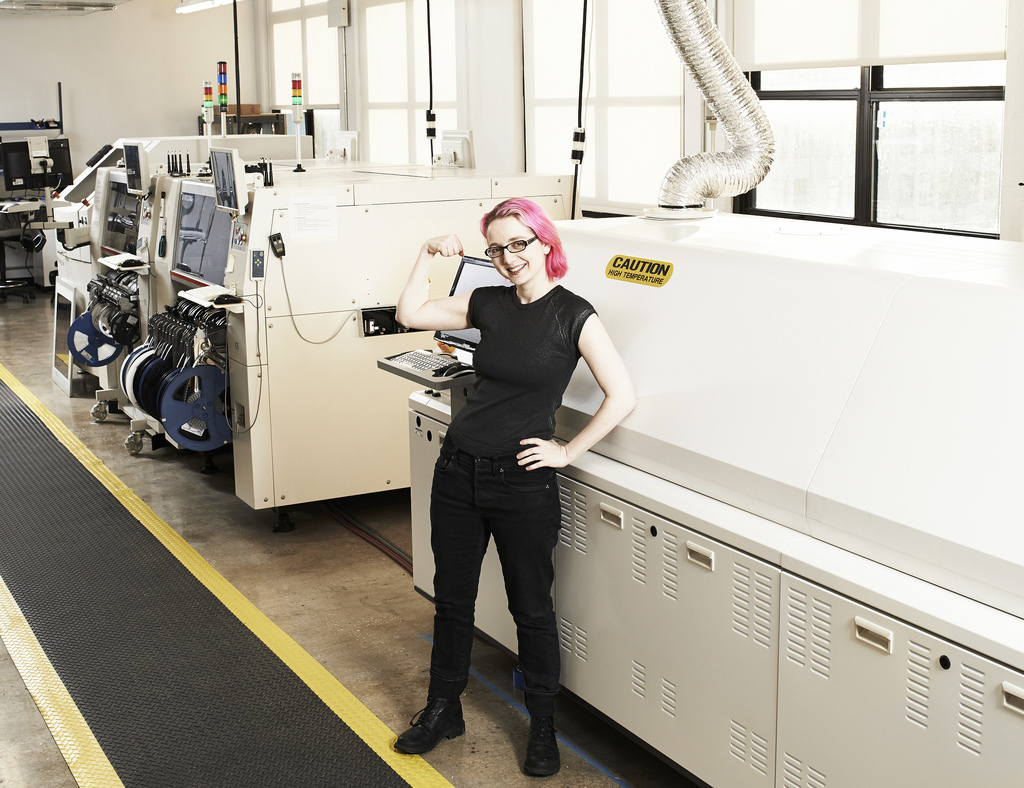
Last month, the White House honored ten makers as “Champions of Change for Making.” These individuals have worked to make their communities better through creative problem solving all across the country, including from as far away as Alaska, and others from Ohio, Oregon, Louisiana, Rhode Island, Texas, New York, and California. The event also featured remarks by U.S. Chief Technology Officer Megan Smith and others, including Roberto Rodriguez, Johan Uvin, Jetta Wong, Tom Kalil as well as a new U.S. Department of Energy video highlighting their maker-related work with the Make Energy Pavilion at the Bay Area Maker Faire and a new NASA video celebrating their maker-mindset. The celebration of these individuals was part of the National Week of Making, which you can read more about on the wrap-up blog post—“A Whole Week of Making!”

The following are reflections shared with us by the Champions of Change for Making:
A. Dara Dotz
As a child I was pretty isolated and it seemed unlikely to me I was ever going to go to college, let alone graduate, until I discovered Industrial Design. I had always wanted to be of service and design has opened up practical ways for me to do so. Recently, this passion has focused my attention on serving people in crisis by using technology to benefit those at the edges, from disaster survivors to astronauts.
Having spent more than decade working in underserved communities in over 37 countries, from Native American reservations to post-earthquake Nepal, I saw first-hand that there was a common denominator amongst the most affected of populations – a lack of reliable supply chain.
Over this same time period, it was exhilarating for me to be a part of Made In Space, the team to build the first gravity independent 3D printer and launch it to the International Space Station (ISS). We then emailed a ratchet to the ISS, not only the fastest delivery to space, but the first off planet manufacturing as well.
Watching my friends in Haiti suffer because they didn’t have access to simple disposable medical devices was what drove me to deploy the first 3D printer to Haiti, initiating the first Maker Lab run by, and for, Haitians. Now instead of waiting for months or years, they can print for themselves what they need, when they need it, at a fraction of the cost.
These experiences led me to co-found Field Ready to enable manufacturing of humanitarian supplies in the field. Co-creating with and for locals by utilizing digital fabrication techniques to create on-demand and as-needed solutions, Field Ready seeks to give people the space and permission to make for each other and themselves builds stronger and more resilient communities.
A. Dara Dotz is a co-founder of Field Ready, a non-profit organization focused on aid supplies delivery through on-demand manufacturing.
Bahiy Watson
Four years ago, my son told me that he wanted to become an engineer. I was shell-shocked because he was looking to enter into a field that I was looking to exit. Working in an extremely technical career, I often found myself isolated as the only, and sometimes first, African American engineer within most departments. Nevertheless, I agreed to help and started by trying to locate science, technology, engineering, and math (STEM) programs for him.
As I looked around our city of New Orleans, my wife's hometown, I was disheartened by the number of African American students who were completely disengaged from math and science, as well as anything resembling school. I knew how other cultures had built wealth through STEM careers, yet African Americans in my community lacked the preparation to be successful in a STEM field. Additionally, all of this was further compounded by student disengagement, the number of New Orleans students living in poverty, an underperforming school system, low ACT scores, along with national data showing that minorities have STEM degrees but don’t get hired, as well as the fact that a disproportionate number of blacks leave STEM fields. Looking at this data, I felt an overwhelming sense that African Americans are alienated, estranged, and marginalized when it comes to our participation in STEM fields.
To combat these negative trends, I contemplated: “What if ...”
- What if we could get African American youth engaged in STEM?
- What if African American youth escaped poverty by entering high-paying STEM fields?
- What if we increased ACT scores?
- What if we created a pipeline for African Americans to enter STEM fields?
- What if there was a support system for African Americans that could decrease STEM attrition?
To answer these questions, I founded The 1881 Institute of Technology (formerly The 1881 Research Institute) to prepare underrepresented populations to enter into STEM fields through our development of alternative school models for high school students who are interested in STEM careers, but who struggle in traditional classroom settings. Our pedagogy is centered on increasing expectations, decreasing traditional lectures, and maximizing hands-on activities.
Bahiy Watson is a mechanical engineer within the aerospace industry for 17 years and is the founder and executive director of The 1881 Institute of Technology
Felton Thomas
Over thirty years ago, I made one of the best decisions of my life when I decided to work as a student shelver for the Las Vegas-Clark County Library District. I could have never imagined then that one day my work in libraries would lead me to be honored at the White House. The experience was surreal and I’m still pinching myself to make sure it wasn’t a dream, but one thing became very clear to me during my visit: there are some very talented people across the country doing some truly heroic work involving the maker movement.
As I heard the presentations of the other Champions of Change, I became keenly aware of the power and diversity of making. In libraries, we tend to concentrate our focus of making around entrepreneurship or job creation, so it was awe-inspiring to hear others such as Renee Fredericks talk about how she uses the creation of Native crafts and fabrication to preserve Native Alaskan traditions.
All of this has moved me to think differently about the role of making. I see it now as a shaper of culture, and I’m motivated to elevate our work here in Cleveland. We have started conversations about how we can support a staff member to organize the maker movement in Cleveland, and we are also stepping up our profile in the making networks that currently exists. I’m excited about our future in the movement and I believe that Cleveland’s culture will flourish because of it.
Felton Thomas is the executive director of the Cleveland Public Library and the president of the Public Library Association.

Gregg Behr
While traveling recently, I noticed a billboard that included the tagline “a future based on craftsmanship.” Isn’t that, in many ways, what the maker movement offers? Futures in which the learners themselves design what comes next. Craftsmanship reimagined as a contemporary approach to storytelling or artistry or invention.
The Pittsburgh region has embraced this mindset for its young people as more than 250 organizations—including schools, museums, libraries, early learning centers, afterschool programs, colleges, and creative industries—have banded together over the past decade under the umbrella of the Remake Learning Network to design next-generation teaching and learning experiences in and out of schools, Pre-K through higher education, so that all youth might acquire the knowledge, skills, and dispositions that will help them invent brilliant futures for themselves and for our region.
Now, as a result, on any given day in Pittsburgh, a young person can access a deliberate pathway of learning based on his or her own interests and curiosities. For instance, a young person inspired while tinkering at the Fab Lab at the Carnegie Science Center might be directed to The Labs at the Carnegie Library, where artists and technologists support her in coding a robot or animating a short film. That, in turn, may lead her to Assemble, a community space for arts and technology, where she thrives in hands-on learning during Girls’ Maker Night. Soon thereafter, she may find herself exhibiting her ideas for 3-D printed drones or wearables crafted with advanced textiles during the Maker Faire held at the Children’s Museum of Pittsburgh. Along the way, she’s been supported by her teachers and classmates from Avonworth, Elizabeth Forward, or South Fayette, innovative public school districts integrating STEM, STEAM, maker, and technology-enhanced learning across their K-12 curricula.
This work to remake learning in all the places where kids learn is a decade in the making; and in the years ahead, Pittsburgh’s educators and makers will construct even more authentic and genuine learning pathways for youth, utilizing our region as a campus for learning. What better place than Pittsburgh to forge futures based on craftsmanship remade for our times?
Gregg Behr is the executive director of The Grable Foundation and co-chair of the Remake Learning Council.

John Niebergall
Building on the success I experienced in my classroom with digital design and fabrication, I began years ago to share my knowledge with other educators in the Northwest. I quickly learned that many school districts are seeking to fill a gap in their technology education programs but often lack the necessary teacher training. To help address this need, I have begun traveling by RV to bring Career and Technical Education (CTE) & STEM education tools to districts across Oregon in a Mobile Fab Lab, with tools including a vinyl cutter, 3D printer, laser cutter and other materials that I use to share my cutting-edge program with teachers and students across the state.
While the technology is often new to students, I am amazed at how quickly they build skills that put them on a pathway to potential explore a design or manufacturing career. Even though my mobile fab lab is temporary, by providing teachers with staff development to continue pushing student innovation and problem solving after I leave, opportunities for students to make continue far beyond my brief time at any one location.
The Oregon Fab Lab project is designed to reach out to multiple districts as well as growing a manufacturing ecosystem in Oregon, Washington and Alaska and I am trying to share the successes I've had with other schools and districts so they can develop similar programs. Although I may be at the end of my classroom career, I am as committed as ever to spreading opportunities for others through my work with the mobile laboratory.
John Niebergall loves fishing and windsurfing and has taught hands-on woods, engineering, and digital fabrication classes for the past 32 years in Oregon.

Lisa Marie Wiley
On 20 November 2011, I was injured during my second deployment with the Army in Afghanistan, resulting in the amputation of my left leg below the knee. Since this event, I have become increasingly aware of the need to communicate concerns and ideas for better and more available aid to the amputee community because of my personal situation. Due to my height and weight I was unable to get a prosthetic without customization or modification. I later learned of the cost for the prosthetics and their production, which increase significantly with each modification. The lack of availability for a combat injured American veteran showed me the need to focus on innovation for this community. I started asking those who live within the community as soon as I could. Since then I have been able to speak with an arsenal of great minds ranging from the highest levels in our government to the children and families of those needing assistance. Out of these conversations, I have undertaken the effort of making more people aware of the need for additional funding and research toward prosthetics and adaptive technology to become available—not only for American Veterans but for the global community in need. From the lowest level I was able to learn and understand the needs and wants that have to be discussed, and I am now looking forward to participating with the movement during both the World Maker Faire New York 2016 and in my role on the Prosthetic & Sensory Aid Federal Advisory Committee, which I will be meeting with in October 2016. Now my mission and hope is to contribute to change the world for the better or die trying. I am willing to work with all of those willing to listen and participate in this effort.
LisaMarie is a returned veteran and advocate who presently serves on the Prosthetic & Sensory Aid Federal Advisory Committee. She is also currently studying biology at the University of San Antonio.
Limor Fried
I'm an engineer and educator that likes to solve problems! One of the first times I remember thinking I'd be an engineer was when I was about 7 or 8 and I saw a bunch of balloons stuck to the ceiling at a local mall after an event. No one could reach them so I went home and constructed a mechanical arm with my dad. After going back, getting on his shoulders and using the balloon catcher device we made, we retrieved all the balloons and gave them to others who also wanted balloons. One of the things I do each day is try to teach and create things that elevate people and help put them on each of our shoulders so they can reach their dreams. Learning electronics and computer science can be intimidating—there's so much to know and do. I have dedicated myself, and have been joined by a committed team, to work on including as many people from as many diverse backgrounds as possible in order to grow what's maker movement—and to do so by creating open-source innovation that brings even more people together and inspires even more collaborative creating.
Limor Fried is founder and engineer of Adafruit Industries, a New York based open-source educational electronics manufacturer.

Renee Fredericks
I have been a lifelong learner. I grew up splitting time between my native state of Alaska and South Dakota where we moved when I was 9 years old. I was always being exposed to a different life, different people, and different ideas than my previous life. I remember working long hot days of construction and concrete work with my dad each summer of my teenage years. This was my introduction to the idea that I could do anything—a feeling that was deepened by the matter-of-fact way my dad expected me to do the same work as the boys. I went to school on the East Coast, joined the Navy, and continued to live a nomadic life of change. All of these experiences gave me a constant flow of insight into the vastness of life’s choices.
Fast forward to 2013, I began working at Cook Inlet Tribal Council (CITC), an Alaska Native non-profit social services organization in my hometown of Anchorage, on a new challenge in the formal education world and a new project creating a Fab Lab. Launched through a partnership with MIT’s Center for Bits and Atoms, this lab was to be a playground for tinkers, makers, creators, dreamers. I knew equipment but I didn’t know as much about the computer-numerically-control side. And so Katie Lee (co-manager and tinkerer) and I began our journey with the amazing support of CITC to craft a place where, with guidance from community volunteers work and our Fab staff, Alaska Native kids can tinker and create; tweak and refine projects; learn and laugh, all while expanding their knowledge of life’s choices, gaining perseverance and skills, tapping into the joy of creating something from your imagination, and realizing that they too can do anything. The stories of Alaskan Native and American Indian youth that are benefiting from the space now every day are truly an inspiration to me and so many others.
Renee is the Director of the Youth Education and Employment Services at Cook Inlet Tribal Council and Co-Manager of the Fab Lab.
Sonya Pryor-Jones
I believe that education is the greatest equalizer. As a first-generation college student born to teenage parents, my public school education was the best investment that my family could make for my future.
Today, I have the tremendous opportunity to pay it forward and support 21st-century educational opportunities for others by supporting communities across the country in accessing the tools and the knowledge to innovate and invent, while creating opportunities to improve their own livelihoods. I am constantly inspired by those I work to support—such as Andrea Lane, an engineering student who facilitates digital fabrication workshops for teachers all over the country, and who was herself first introduced to digital fabrication as a 14 year old student in her high school’s Fab Lab. There is also Noah Rasor, an educator who grew up in a small rural community and now serves as a “guru” in the network. Or Brandyn Armstrong, a young entrepreneur and musician who despite being a high school dropout is now pursuing a bachelor’s degree.
STEM and other innovative education practices can transformer opportunities and create new platforms for near limitless possibilities. With each new success story, we can transcend geography, gender, age, and socio-economic status. We can support all students into the 21st century workplace with the confidence, skills, and know-how needed to thrive.
What an honor it is for me to be an advocate, facilitator, and witness!
Sonya Pryor-Jones is an educator and serves as the Chief Implementation Officer for the Fab Foundation, a non-profit organization that emerged from MIT’s Center for Bits & Atoms Fab Lab Program.
Umberto Crenca
I have a fundamental belief that artists and makers have the ability to transform communities in positive ways. This belief led me to found an un-juried, uncensored forum for the arts called AS220 in downtown Providence, Rhode Island. My initial intention was just to create an open venue where anybody in the community would feel comfortable expressing themselves in any medium, but more than 30 years later, AS220 has gone above and beyond this—as is can be seen by how we purchased and renovated three buildings (totaling more than 90,000 square feet) in downtown Providence that now provide a home for artists to live, work, exhibit and present. AS220 has also been instrumental in Providence’s renaissance from a city with a disinvested urban core to a capital known for its art and culture.
AS220 is committed to our values of accessibility, affordability and equity - values that are fundamentally open source and allow anyone and everyone to participate in the process of innovation. Through years of successes and challenges, AS220 has fostered an environment that supports a creative community of artists and makers by providing access to secure and affordable space, access to tools and technology, and access to knowledge and other people. This metaphorical compost heap creates a rich, fertile environment with endless capacity to grow ideas, capitalizing on the infinite potential of each and every individual in residence. By creating these kinds of spaces and ecosystems ripe for creative activity, we build and sustain strong, agile, and equitable urban communities over the long term. Creating this kind of community is what AS220 strives to achieve with its work in Providence and beyond.
Bert Crenca is the founder and former artistic director of AS220, where he is currently Plenipotentiary (a fully-authorized diplomat acting on behalf of the organization).
Following the lead of these Champions of Change for Making, there are many other makers working to create and innovate in their communities. Share your stories about making at wh.gov/nation-of-makers.
Andrew Coy is the Senior Advisor for Making.

